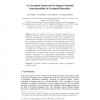Free Online Productivity Tools
i2Speak
i2Symbol
i2OCR
iTex2Img
iWeb2Print
iWeb2Shot
i2Type
iPdf2Split
iPdf2Merge
i2Bopomofo
i2Arabic
i2Style
i2Image
i2PDF
iLatex2Rtf
Sci2ools
ER
2007
Springer
2007
Springer
A Conceptual Framework to Support Semantic Interoperability of Geospatial Datacubes
Today, we observe a wide use of geospatial databases that are implemented in many forms (e.g. transactional centralized systems, distributed databases, multidimensional datacubes). Among those possibilities, the multidimensional datacube is more appropriate to support interactive analysis and to guide the organization’s strategic decisions, especially when different epochs and levels of information granularity are involved. However, one may need to use several geospatial multidimensional datacubes which may be heterogeneous in design or content. Overcoming the heterogeneity problems in a manner that is transparent to users has been the principal aim of interoperability for the last fifteen years. In spite of successful initiatives and widespread use of standards, today's solutions do not address yet geospatial datacubes. This paper aims at describing the interoperability of geospatial datacubes, defining the semantic heterogeneity problems that may occur when using different geo...
| Added | 07 Jun 2010 |
| Updated | 07 Jun 2010 |
| Type | Conference |
| Year | 2007 |
| Where | ER |
| Authors | Tarek Sboui, Yvan Bédard, Jean Brodeur, Thierry Badard |
Comments (0)

